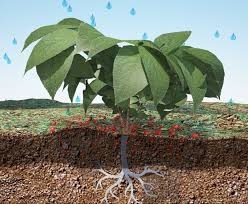
By the end of this short article you will hopefully understand the following statement.
“For good crop growth, maintaining water above stress point will maximise vegetative growth. Setting a refill point above stress point will ensure there is always readily available water for the crop. Replacing irrigation with no more water than a soil’s field capacity will minimise drainage, allowing irrigators to maximise fertiliser applications. “
There are a few terms used to describe soil water and how much water is available to a plant. These are handy to know and can make a difference when reading and interpreting soil moisture graphs and setting your irrigation.
Water is held in the gaps between (pore space) soil particles and around their surface. The soil particle size and distribution influence the soil’s water holding capacity. Generally the smaller the particles and the greater the organic matter, the greater the surface area for water to be held. Fine textured soils like clays and silts have a high total water holding capacity.
Field Capacity describes the water a soil can hold, after excess water has drained from the soil. This is influenced by gravity(the weight of the water) and the surface tension exerted by the soil particles. If soil is above field capacity, then drainage will occur.

Moisture that a plant can easily remove from soil is called readily available water. At field capacity, available water is high and a plant only need exert a low suction force to overcome the tension holding the water in the soil.
As soil moisture is depleted, less water is held between soil particles and more around the surface of the soil particles. The force required to remove the remaining water increases as soil water is depleted and a plant must apply greater suction to overcome the surface tension holding the water in the soil.
A plant uses water for cellular function, growth and to cool itself. If readily available water is exhausted, a plant may be using more energy extracting water from the soil, creating more heat than it can remove from itself.
When this occurs, a plant uses energy otherwise put into growth for cooling, reducing potential yields. This is the stress point. In leafy crops, stress is undesirable and will reduce maximum potential yield. In some fruit and vine crops, stress is induced to reduce fruit size and increase sugars and firmness.
To maintain good plant growth, water in the soil should be applied via irrigation or rainfall at a suitable level of stress for the crop being grown. This is called the refill point.
When a crop is unable to remove heat from itself and is losing more water than it can extract from the environment, it will close down cells in the leaves causing the plant to droop. This is the wilt point and a plant can recover when the environment cools down or water availability increases.
If water availability decreases further and too much water is lost cells will die and a plant may not be able to recover. This is called the permanent wilt point.